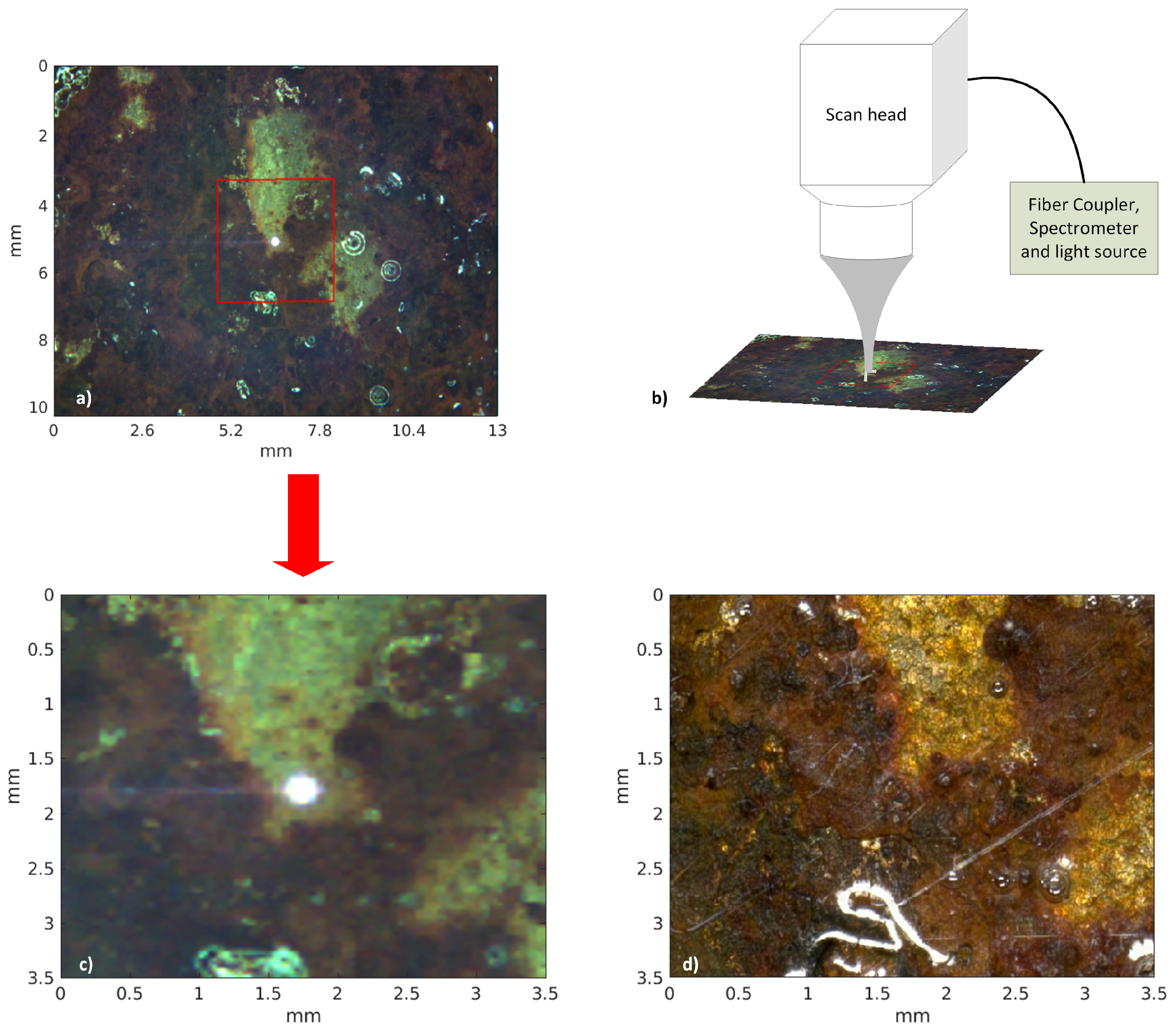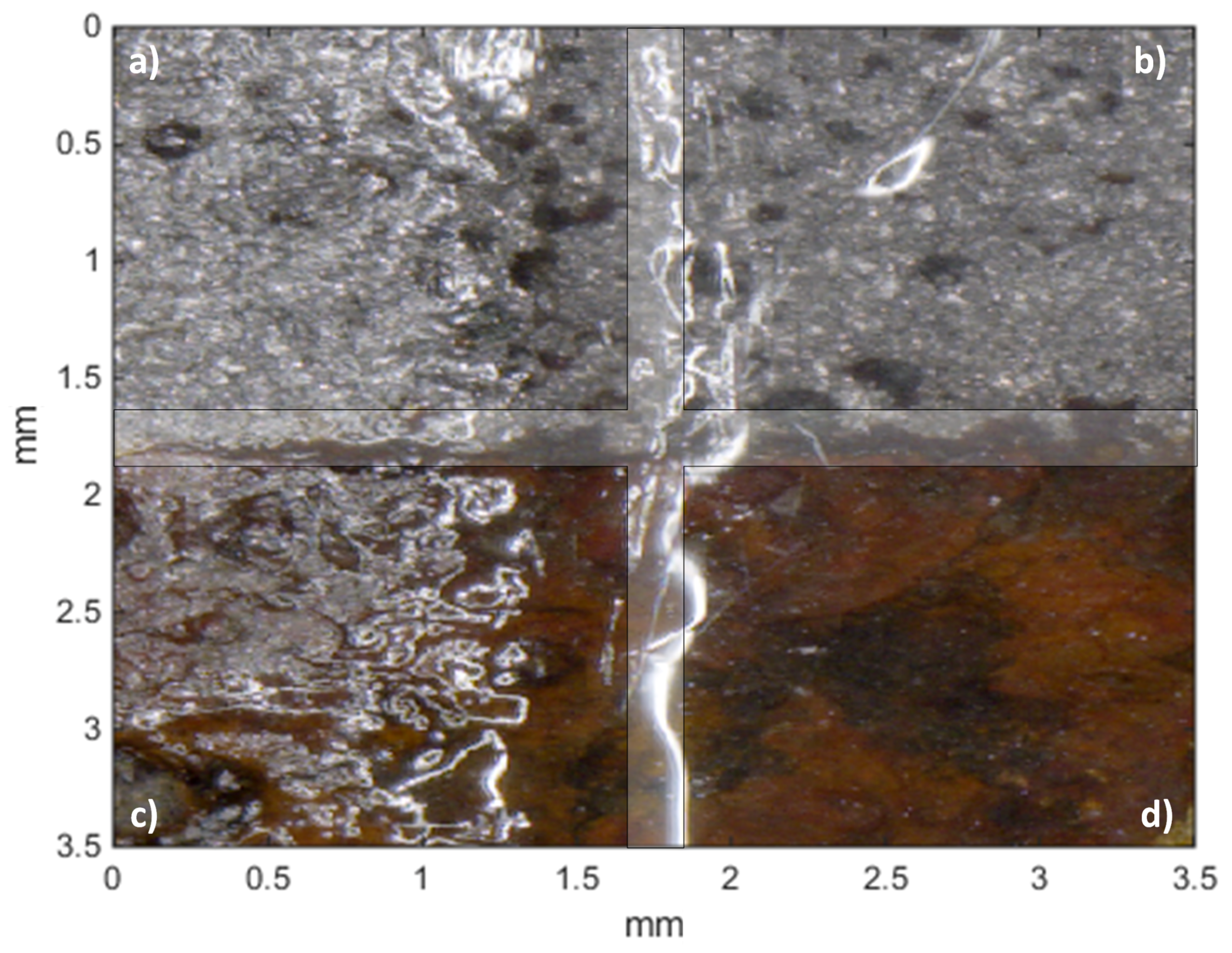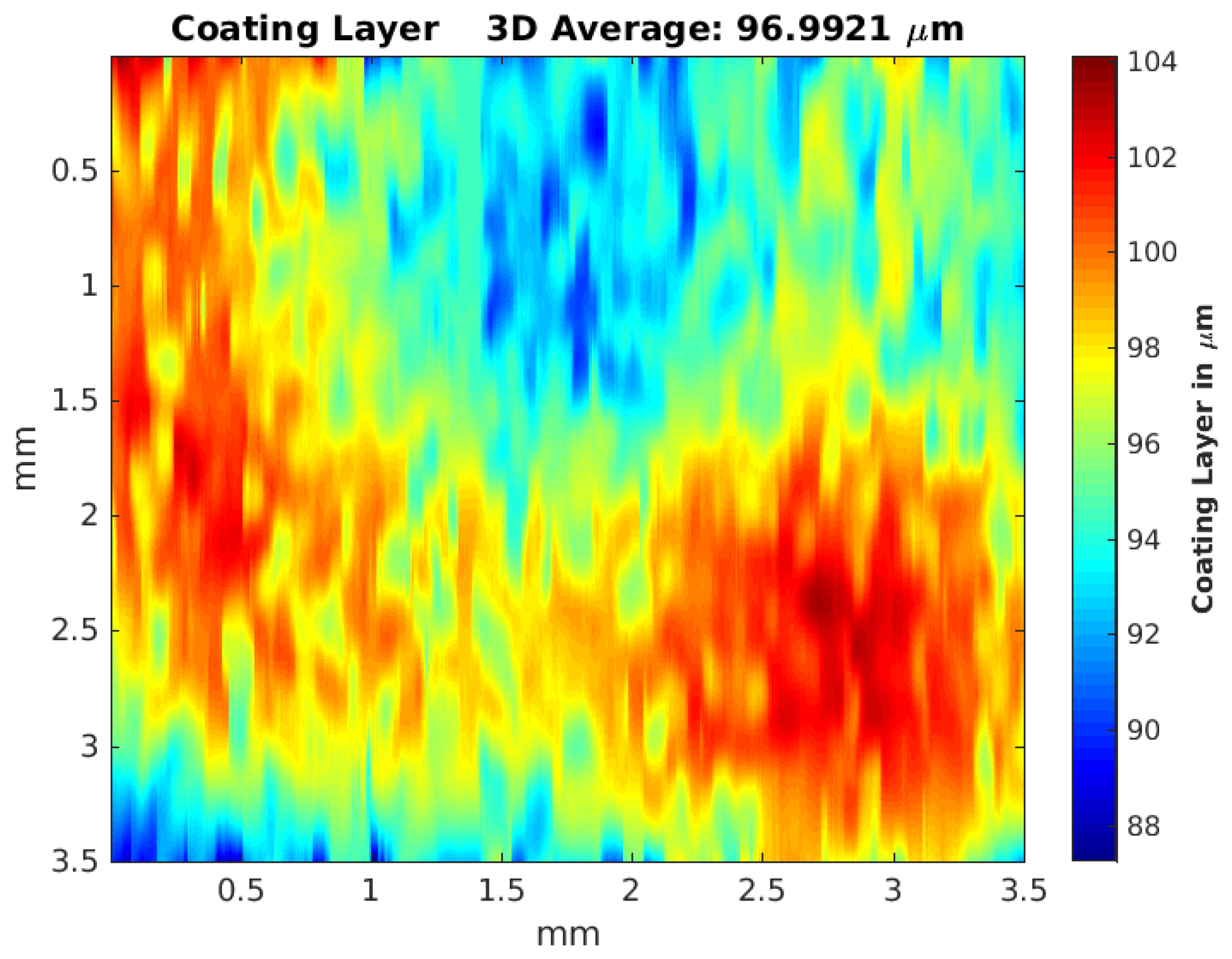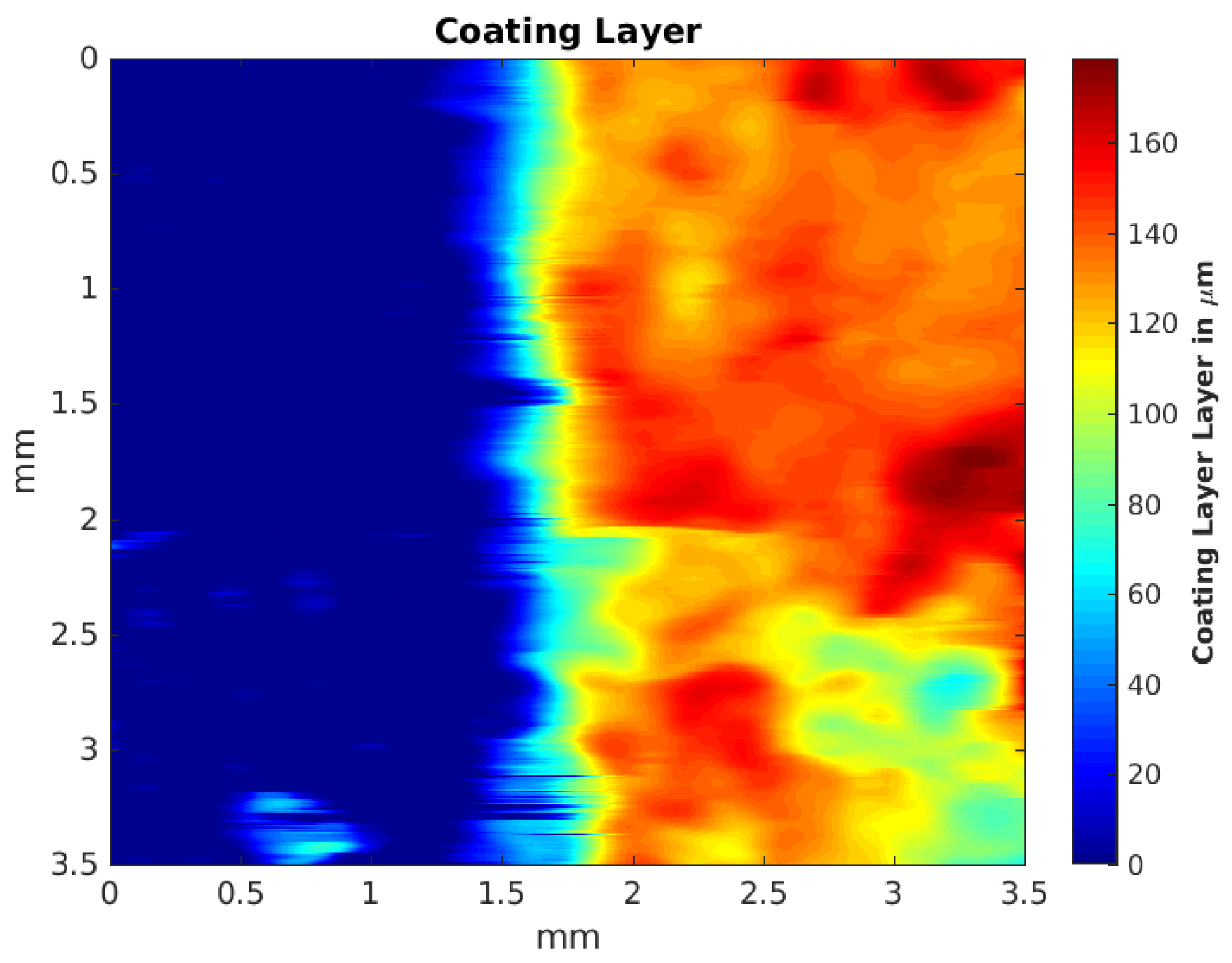Spectral Domain Optical Coherence Tomography for Non-Destructive Testing of Protection Coatings on Metal Substrates
Abstract
:1. Introduction
2. Methodology
2.1. Systems
2.2. Samples
2.2.1. Coated Bare Metal Samples
2.2.2. Customized Sectioned Sample
- Embedding in a 5% NaCl-solution
- Exposure to 100% relative humidity for 8 h at 40
- Drying for 16 h at room temperature
- Repetition of steps 1 to 3 five times
- Exposure to outdoor weathering for 2 months inclination , south-side exposure
- Desalination by immersion with distilled water
- Soft air abrasive cleaning with walnut shells (pressure 8 bar, distance 50 cm)
- Additional air abrasive cleaning for half of the sample (upper part) until bare metal was reached.
- Application of coatings by brush, five to six repetitions (resulting layers), intermediate drying period of 3–4 h for each layer.
2.2.3. Standard Sample
2.3. Post-Processing
3. Results
3.1. Coated Bare Metal Samples
3.2. Customized Sectioned Sample
3.3. Standard Sample
4. Discussion
5. Conclusions
Acknowledgments
Author Contributions
Conflicts of Interest
References
- Hee, M.R.; Izatt, J.A.; Swanson, E.A.; Huang, D.; Schuman, J.S.; Lin, C.P.; Puliafito, C.A.; Fujimoto, J.G. Optical coherence tomography of the human retina. Arch. Ophthalmol. 1995, 113, 325–332. [Google Scholar] [CrossRef] [PubMed]
- Welzel, J.; Lankenau, E.; Birngruber, R.; Engelhardt, R. Optical coherence tomography of the human skin. J. Am. Acad. Dermatol. 1997, 37, 958–963. [Google Scholar] [CrossRef]
- Drexler, W.; Fujimoto, J.G. Optical Coherence Tomography: Technology and Applications; Springer Science & Business Media: Berlin/Heidelberg, Germany, 2008. [Google Scholar]
- Rouba, B.; Karaszkiewicz, P.; Tymioska-Widmer, L.; Iwanicka, M.; Góra, M.; Kwiatkowska, E.; Targowski, P. Optical coherence tomography for non-destructive investigations of structure of objects of art. J. Nondestruct. Test. 2008, 13. [Google Scholar] [CrossRef]
- Targowski, P.; Iwanicka, M.; Tymioska-Widmer, L.; Sylwestrzak, M.; Kwiatkowska, E.A. Structural examination of easel paintings with optical coherence tomography. Acc. Chem. Res. 2009, 43, 826–836. [Google Scholar] [CrossRef] [PubMed]
- Targowski, P.; Iwanicka, M. Optical coherence tomography: Its role in the non-invasive structural examination and conservation of cultural heritage objects—A review. Appl. Phys. A 2012, 106, 265–277. [Google Scholar] [CrossRef]
- Wiesauer, K.; Pircher, M.; Götzinger, E.; Hitzenberger, C.K.; Oster, R.; Stifter, D. Investigation of glass–fibre reinforced polymers by polarisation-sensitive, ultra-high resolution optical coherence tomography: Internal structures, defects and stress. Compos. Sci. Technol. 2007, 67, 3051–3058. [Google Scholar] [CrossRef]
- Stifter, D.; Wiesauer, K.; Wurm, M.; Schlotthauer, E.; Kastner, J.; Pircher, M.; Götzinger, E.; Hitzenberger, C. Investigation of polymer and polymer/fibre composite materials with optical coherence tomography. Measur. Sci. Technol. 2008, 19, 074011. [Google Scholar] [CrossRef]
- Duncan, M.D.; Bashkansky, M.; Reintjes, J. Subsurface defect detection in materials using optical coherence tomography. Opt. Express 1998, 2, 540–545. [Google Scholar] [CrossRef] [PubMed]
- Stifter, D.; Burgholzer, P.; Höglinger, O.; Götzinger, E.; Hitzenberger, C.K. Polarisation-sensitive optical coherence tomography for material characterisation and strain-field mapping. Appl. Phys. A 2003, 76, 947–951. [Google Scholar] [CrossRef]
- Wiesauer, K.; Pircher, M.; Götzinger, E.; Bauer, S.; Engelke, R.; Ahrens, G.; Grützner, G.; Hitzenberger, C.; Stifter, D. En-face scanning optical coherence tomography with ultra-high resolution for material investigation. Opt. Express 2005, 13, 1015–1024. [Google Scholar] [CrossRef] [PubMed]
- Zhong, S.; Shen, Y.C.; Ho, L.; May, R.K.; Zeitler, J.A.; Evans, M.; Taday, P.F.; Pepper, M.; Rades, T.; Gordon, K.C.; et al. Non-destructive quantification of pharmaceutical tablet coatings using terahertz pulsed imaging and optical coherence tomography. Opt. Lasers Eng. 2011, 49, 361–365. [Google Scholar] [CrossRef]
- Lin, H.; Dong, Y.; Shen, Y.; Zeitler, J.A. Quantifying pharmaceutical film coating with optical coherence tomography and terahertz pulsed imaging: An evaluation. J. Pharm. Sci. 2015, 104, 3377–3385. [Google Scholar] [CrossRef] [PubMed]
- Serrels, K.A.; Renner, M.K.; Reid, D.T. Optical coherence tomography for non-destructive investigation of silicon integrated-circuits. Microelectron. Eng. 2010, 87, 1785–1791. [Google Scholar] [CrossRef]
- Stifter, D. Beyond biomedicine: A review of alternative applications and developments for optical coherence tomography. Appl. Phys. B 2007, 88, 337–357. [Google Scholar] [CrossRef]
- Nemeth, A.; Leiss-Holzinger, E.; Hannesschläger, G.; Wiesauer, K.; Leitner, M. Optical Coherence Tomography- Applications in Non-Destructive Testing and Evaluation; INTECH Open Access Publisher: Rijeka, Croatia, 2013. [Google Scholar]
- Mazzon, C.; Letardi, P.; Brüggerhoff, S. Development of Monitoring Techniques for Coatings Applied to Industrial Heritage. In Proceedings of the BigStuff 2015–Technical Heritage: Preserving Authenticity-Enabling Identity, Lewarde, France, 3–4 September 2015. [Google Scholar]
- Mansfeld, F. Electrochemical impedance spectroscopy (EIS) as a new tool for investigating methods of corrosion protection. Electrochim. Acta 1990, 35, 1533–1544. [Google Scholar] [CrossRef]
- Letardi, P.; Spiniello, R. Characterisation of Bronze Corrosion and Protection by Contact-Probe Electrochemical Impedance Measurements. In Proceedings of the Metal 2001: Proceedings of the International Conference on Metals Conservation, Santiago, Chile, 2–6 April 2001; Western Australian Museum: Fremental, Australia, 2004; pp. 316–319. [Google Scholar]
- Mottner, P. Investigations of Transparent Coatings for the Conservation of Iron and Steel Outdoor Industrial Monuments. In Proceedings of the Metal 2001: Proceedings of the International Conference on Metals Conservation, Santiago, Chile, 2–6 April 2001; Western Australian Museum: Fremental, Australia, 2004; pp. 279–288. [Google Scholar]
- Angelini, E.P.M.V.; Assante, D.; Grassini, S.; Parvis, M. EIS measurements for the assessment of the conservation state of metallic works of art. Int. J. Circuits Syst. Signal Process. 2014, 8, 240–245. [Google Scholar]
- Cano, E.; Crespo, A.; Lafuente, D.; Barat, B.R. A novel gel polymer electrolyte cell for in-situ application of corrosion electrochemical techniques. Electrochem. Commun. 2014, 41, 16–19. [Google Scholar] [CrossRef]
- Cano, E.; Lafuente, D.; Bastidas, D.M. Use of EIS for the evaluation of the protective properties of coatings for metallic cultural heritage: A review. J. Solid State Electrochem. 2010, 14, 381–391. [Google Scholar] [CrossRef]
- Ellingson, L.A.; Shedlosky, T.J.; Bierwagen, G.P.; de la Rie, E.R.; Brostoff, L. The use of electrochemical impedance spectroscopy in the evaluation of coatings for outdoor bronze. Stud. Conserv. 2013, 49, 53–62. [Google Scholar] [CrossRef]
- Hallam, D.; Thurrowgood, D.; Otieno-Alego, V.; Creagh, D. An EIS Method for Assessing Thin Oil Films Used in Museums. In Proceedings of the Metal 2004 National Museum of Australia Canberra ACT, Canberra, Australia, 4–8 October 2004; Volume 4, p. 8. [Google Scholar]
- Letardi, P. Corrosion and Conservation of Cultural Heritage Metallic Artefacts: 7. Electrochemical Measurements in the Conservation of Metallic Heritage Artefacts: An Overview; Elsevier Inc.: Amsterdam, The Netherlands, 2013. [Google Scholar]
- Letardi, P.; Beccaria, A.; Marabelli, M.; D’ERCOLI, G. Application of Electrochemical Impedance Measurements as a Tool for the Characterization of the Conservation and Protection State of Bronze Works of Art. In Proceedings of the Conférence Internationale sur la Conservation des Métaux, Draguignan, France, 27–29 May 1998; pp. 303–308. [Google Scholar]
- Mansfeld, F. Use of electrochemical impedance spectroscopy for the study of corrosion protection by polymer coatings. J. Appl. Electrochem. 1995, 25, 187–202. [Google Scholar] [CrossRef]
- Price, C.; Hallam, D.; Heath, G.; Creagh, D.; Ashton, J. An Electrochemical Study of Waxes for Bronze Sculpture. In Proceedings of the Conférence Internationale sur la Conservation des Métaux, Semur en Auxois, France, 25–28 September 1995; pp. 233–241. [Google Scholar]
- Amirudin, A.; Thieny, D. Application of electrochemical impedance spectroscopy to study the degradation of polymer-coated metals. Prog. Org. Coat. 1995, 26, 1–28. [Google Scholar] [CrossRef]
- Fischer, H. Electromagnetic Probe for Measuring the Thickness of Thin Coatings on Magnetic Substrates. US Patent 4,829,251, 9 May 1989. [Google Scholar]
- Wolfram, J.; Brüggerhoff, S.; Eggert, G. Better Than Paraloid B-72? Testing Poligen Waxes as Coatings for Metal Objects. In Proceedings of the METAL 2010: Proceedings of the Interim Meeting of the ICOM-CC Metal Working Group, Clemson University, Clemson, SC, USA, 11–15 October 2010; pp. 124–131. [Google Scholar]
- Antoniuk, P.; Strąkowski, M.; Pluciński, J.; Kosmowski, B. Non-Destructive Inspection of Anti-corrosion protective coatings using optical coherent tomography. Metrol. Measur. Syst. 2012, 19, 365–372. [Google Scholar] [CrossRef]
- Derrick, M. Paraloid B-48N. Available online: http://cameo.mfa.org/wiki/ParaloidB-48N (accessed on 16 January 2017).
- Decker, P.; Brüggerhoff, S.; Eggert, G. To coat or not to coat? The maintenance of Cor-Ten® sculptures. Mater. Corros. 2008, 59, 239–247. [Google Scholar] [CrossRef]
- Seipelt, B.; Pilz, M.; Kiesenberg, J. Transparent Coatings-Suitable Corrosion Protection for Industrial Heritage Made of Iron? In Proceedings of the Conférence Internationale sur la Conservation des Métaux, Draguignan, France, 27–29 May 1998; pp. 291–296. [Google Scholar]
- Dubois, A.; Vabre, L.; Boccara, A.C.; Beaurepaire, E. High-resolution full-field optical coherence tomography with a Linnik microscope. Appl. Opt. 2002, 41, 805–812. [Google Scholar] [CrossRef] [PubMed]
- Wang, Z.; Potsaid, B.; Chen, L.; Doerr, C.; Lee, H.C.; Nielson, T.; Jayaraman, V.; Cable, A.E.; Swanson, E.; Fujimoto, J.G. Cubic meter volume optical coherence tomography. Optica 2016, 3, 1496–1503. [Google Scholar] [CrossRef] [PubMed]
- Klein, T.; Huber, R. High-speed OCT light sources and systems [Invited]. Biomed. Opt. Express 2017, 8, 828–859. [Google Scholar] [CrossRef] [PubMed]








| Concept | Sample 1 | Sample 2 | Sample 3 | Sample 4 | Sample 5 | Sample 6 * |
|---|---|---|---|---|---|---|
| OCT | 6.86 | 22.97 | 42.27 | 48.91 | 97.00 | 80.24 |
| std. OCT | 0.65 | 1.61 | 2.01 | 2.52 | 2.74 | 1.85 |
| MI | 7.16 | 21.89 | 43.85 | 56.57 | 83.34 | 88.70 |
| std. MI | 1.14 | 1.5 | 3.8 | 9.81 | 9.47 | 2.5 |
| expected th. value | 11.27 | 27.44 | 53.70 | 64.10 | 94.30 | 86.26 |
© 2017 by the authors. Licensee MDPI, Basel, Switzerland. This article is an open access article distributed under the terms and conditions of the Creative Commons Attribution (CC BY) license (http://creativecommons.org/licenses/by/4.0/).
Share and Cite
Lenz, M.; Mazzon, C.; Dillmann, C.; Gerhardt, N.C.; Welp, H.; Prange, M.; Hofmann, M.R. Spectral Domain Optical Coherence Tomography for Non-Destructive Testing of Protection Coatings on Metal Substrates. Appl. Sci. 2017, 7, 364. https://doi.org/10.3390/app7040364
Lenz M, Mazzon C, Dillmann C, Gerhardt NC, Welp H, Prange M, Hofmann MR. Spectral Domain Optical Coherence Tomography for Non-Destructive Testing of Protection Coatings on Metal Substrates. Applied Sciences. 2017; 7(4):364. https://doi.org/10.3390/app7040364
Chicago/Turabian StyleLenz, Marcel, Cristian Mazzon, Christopher Dillmann, Nils C. Gerhardt, Hubert Welp, Michael Prange, and Martin R. Hofmann. 2017. "Spectral Domain Optical Coherence Tomography for Non-Destructive Testing of Protection Coatings on Metal Substrates" Applied Sciences 7, no. 4: 364. https://doi.org/10.3390/app7040364




